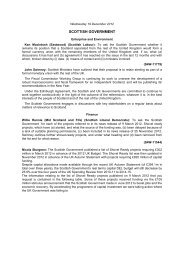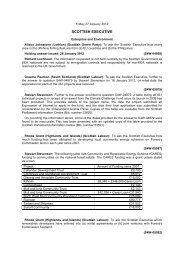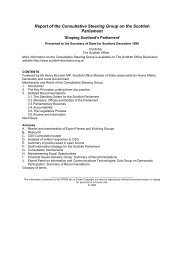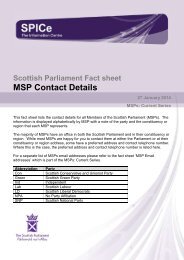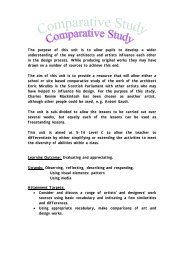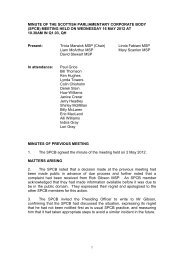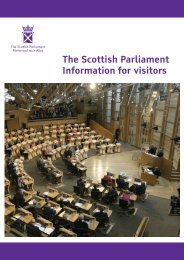PDF Version - Scottish Parliament
PDF Version - Scottish Parliament
PDF Version - Scottish Parliament
Create successful ePaper yourself
Turn your PDF publications into a flip-book with our unique Google optimized e-Paper software.
The <strong>Scottish</strong> <strong>Parliament</strong> - Past and Present<br />
Find out how the <strong>Scottish</strong> <strong>Parliament</strong> has evolved through the<br />
ages, from the assembly meetings of nobles and churchmen in<br />
1235 to the modern <strong>Parliament</strong> that exists today.<br />
1200 1300 1400 1500 1600 1700 1800 1900 2000<br />
© <strong>Scottish</strong> <strong>Parliament</strong>ary Corporate Body
1235<br />
THE FIRST MENTION OF A<br />
SCOTTISH PARLIAMENT<br />
The use of the word ‘colloquium’ in this<br />
act, referring to a meeting at Kirkliston in<br />
1235, marks the first surviving evidence for a<br />
parliamentary assembly in Scotland.<br />
This is the earliest written mention of a<br />
<strong>Parliament</strong>; it refers to an assembly held at<br />
Kirkliston on the outskirts of Edinburgh. The<br />
<strong>Parliament</strong> developed from meetings of the<br />
“King’s great council”, which were gatherings<br />
of nobles and churchmen who advised the<br />
king on policy and justice issues.<br />
1293<br />
THE EARLIEST SURVIVING ROLL<br />
FROM PARLIAMENT<br />
The official seal of John Balliol. This seal,<br />
showing the King on his throne, was attached<br />
to documents as a sign of royal approval.<br />
The earliest official parliamentary roll dates<br />
from the first <strong>Parliament</strong> of John Balliol, who<br />
was King of Scots from 1292 to 1296. It records<br />
what happened at the parliamentary session of<br />
February 1293.<br />
1200 1300 1400 1500 1600 1700 1800 1900 2000<br />
The <strong>Scottish</strong> <strong>Parliament</strong> - Past and Present PAGE 2
1309<br />
DECLARATION OF THE CLERGY<br />
Bronze statue of King Robert Bruce,<br />
commemorating his victory at the 1314 Battle<br />
of Bannockburn.<br />
The clergy (churchmen) declared their support<br />
for King Robert Bruce in <strong>Parliament</strong>. This was<br />
important as Scotland’s continued independence<br />
was in doubt at the time.<br />
1357<br />
THE FIRST MENTION OF THE<br />
THREE ESTATES<br />
Coin of David II (1324-71)<br />
The first surviving record in Scotland using the<br />
term “Three Estates”, which referred to the three<br />
groups that made up the <strong>Parliament</strong> – the clergy<br />
(churchmen), nobility and the burgh (town)<br />
commissioners.<br />
1200 1300 1400 1500 1600 1700 1800 1900 2000<br />
The <strong>Scottish</strong> <strong>Parliament</strong> - Past and Present PAGE 3
1424<br />
ACTS OF PARLIAMENT BEGIN TO BE<br />
RECORDED IN SCOTS<br />
Acts of parliament from the reign of James I,<br />
written in Scots rather than Latin.<br />
Before this date, most of the surviving<br />
documents are written in Latin, which was<br />
the language of official documents at the<br />
time. King James I, however, began to keep<br />
his parliamentary records in Scots, a language<br />
that most people could understand. The 1424<br />
Royal Mines Act is the oldest act still in force in<br />
Scotland today, which states that gold and silver<br />
mines belong to the monarch.<br />
1425-26<br />
PARLIAMENT FLEXES ITS MUSCLE<br />
James I (1394-1437)<br />
King James made several attempts to make<br />
<strong>Parliament</strong> more obedient. These included<br />
suggesting changes that would have made<br />
<strong>Parliament</strong> more like the one in England. These<br />
changes failed, which helped <strong>Parliament</strong> to<br />
maintain a strong, and often independent, voice<br />
for the next two centuries.<br />
1436<br />
FAILED ATTEMPT TO CURB ROYAL POWER<br />
Plate from the sixteenth-century “Forman<br />
Armorial”, showing James I and his wife Joan<br />
Beaufort wearing heraldic dress.<br />
Sir Robert Graham, speaker of the Estates,<br />
attempted to arrest James I ‘in the name of all<br />
the Three Estates of your realm’, but received no<br />
support from the <strong>Parliament</strong>. Graham was put in<br />
prison, but released and took part in the murder<br />
of the king at Perth on 21st February 1437.<br />
1200 1300 1400 1500 1600 1700 1800 1900 2000<br />
The <strong>Scottish</strong> <strong>Parliament</strong> - Past and Present PAGE 4
1445<br />
A CONTRACTED KING<br />
James II ruled from 1437 to 1460, an unstable<br />
period where various groups battled for power<br />
over Scotland.<br />
King James II swore an oath not to alter<br />
legislation (laws) without <strong>Parliament</strong>’s consent.<br />
1455<br />
INSTITUTING A PROPER DRESS CODE<br />
Detail from a 17th-century print showing<br />
the 1685 ‘Riding of <strong>Parliament</strong>’, a colourful<br />
horseback procession which took place at the<br />
opening of each session.<br />
<strong>Parliament</strong> introduced a dress code for its<br />
members, specifying what kind of velvet cloak<br />
could be worn, its colour and what type of fur<br />
it should be lined with. Anyone who came to<br />
<strong>Parliament</strong> wrongly dressed was to be fined £10<br />
Scots.<br />
1458<br />
PARLIAMENT ORDERS THE SLAUGHTER<br />
OF WOLVES<br />
Act of <strong>Parliament</strong> ordering landowners to<br />
seek out and destroy any wolves and their<br />
offspring within their area.<br />
<strong>Parliament</strong> passed a number of acts in the<br />
fifteenth century making it not just legal but<br />
required to hunt and persecute wolves. Hunts<br />
were held four times a year and huntsmen<br />
were paid sixpence for each wolf’s head<br />
brought to a sheriff. Such measures meant the<br />
wolf was extinct in Scotland by the eighteenth<br />
century.<br />
1200 1300 1400 1500 1600 1700 1800 1900 2000<br />
The <strong>Scottish</strong> <strong>Parliament</strong> - Past and Present PAGE 5
1471<br />
FOOTBALL AND GOLF BANNED<br />
A parliamentary act banning people from<br />
playing ‘fute-ball and the golf’.<br />
Sport and similar leisure activities were strictly<br />
controlled by <strong>Parliament</strong>, since it was thought<br />
that these were distractions from everyday work.<br />
Football and golf were banned in the fifteenth<br />
century so that men of fighting-age would<br />
practice archery, a more useful skill to have for<br />
defending against any attackers.<br />
1496<br />
FIRST EDUCATION ACT<br />
The 1496 Education Act ensured that<br />
schooling was more widespread, both<br />
geographically and socially, in Scotland than<br />
in most other European countries.<br />
<strong>Parliament</strong> passed an act making schooling<br />
compulsory from the age of eight for the<br />
sons of barons and wealthy landowners. The<br />
reasoning behind the act was to ensure that<br />
people who became sheriffs or judges would<br />
have a proper understanding of the law.<br />
1200 1300 1400 1500 1600 1700 1800 1900 2000<br />
The <strong>Scottish</strong> <strong>Parliament</strong> - Past and Present PAGE 6
1532<br />
FOUNDATION OF THE COURT OF<br />
SESSION<br />
The Great Window in <strong>Parliament</strong> House,<br />
Edinburgh, shows the founding of the Court of<br />
Session in 1532 by James V.<br />
<strong>Parliament</strong> passed an act setting up the Court of<br />
Session, the supreme civil court in Scotland, for<br />
the “universal well-being” of everyone. This was<br />
a major step forward towards a fully developed<br />
and modern legal system. The Court of Session<br />
still exists today as part of the College of Justice,<br />
a body bringing together all the supreme courts<br />
in Scotland.<br />
1560<br />
THE REFORMATION PARLIAMENT<br />
John Knox, popular preacher and one of<br />
the religious leaders of the Protestant<br />
Reformation<br />
<strong>Parliament</strong> set the seal on a religious revolution<br />
by breaking the connection with the Pope<br />
and the Catholic Church and establishing the<br />
Protestant religion.<br />
1563<br />
WITCHCRAFT ACT<br />
An illustration depicting the Devil speaking<br />
to a group of witches at North Berwick in<br />
1590-91.<br />
Following lobbying from the Church,<br />
<strong>Parliament</strong> passed an act which meant<br />
that anyone practising witchcraft would be<br />
punished by death. Consequently hundreds of<br />
witches were tried and put to death, with the<br />
last execution taking place at Dornoch in 1722.<br />
1200 1300 1400 1500 1600 1700 1800 1900 2000<br />
The <strong>Scottish</strong> <strong>Parliament</strong> - Past and Present PAGE 7
1579<br />
POOR LAW ENACTED<br />
Detail from a printed copy of the 1579 Poor<br />
Law, which put in place severe punishments<br />
for ‘vagabounds and idle beggars’.<br />
A new, harsh law was passed by <strong>Parliament</strong><br />
to control the administration of help to the<br />
growing numbers of poor people. This increase<br />
had been caused by a rising population and<br />
repeated food shortages. The act said that an<br />
able-bodied poor person who refused to work<br />
should be whipped and placed in the stocks.<br />
1587<br />
THREE BECOME FOUR<br />
Detail from a seventeenth-century sederunt,<br />
or attendance roll, noting the parliamentary<br />
representatives for the shires of Stirling,<br />
Linlithgow, Perth and Kincardine.<br />
<strong>Parliament</strong> passed an act regulating the<br />
attendance by commissioners from the shires<br />
(rural areas). Although they had attended<br />
<strong>Parliament</strong> in some numbers in the past,<br />
their presence was not made official until this<br />
act, which allowed each shire to elect two<br />
representatives.<br />
1200 1300 1400 1500 1600 1700 1800 1900 2000<br />
The <strong>Scottish</strong> <strong>Parliament</strong> - Past and Present PAGE 8
1604<br />
PARLIAMENTARY UNION WITH<br />
ENGLAND PROPOSED<br />
James VI (1566-1625) in 1604<br />
In 1603, the Union of the Crowns took place<br />
when James VI became king of England as well as<br />
Scotland. He moved south to London and shortly<br />
after, he proposed the union of his English<br />
and <strong>Scottish</strong> parliaments, but neither side was<br />
enthusiastic and the project was abandoned.<br />
1632<br />
THE BUILDING OF PARLIAMENT HOUSE<br />
IN EDINBURGH<br />
<strong>Parliament</strong> House, next to St Giles’<br />
Cathedral, Edinburgh<br />
The building of <strong>Parliament</strong> House in Edinburgh<br />
began on a site just off the Royal Mile. This<br />
provided a permanent meeting place for the<br />
first time. The first meeting was held in the new<br />
building in 1639. Most of <strong>Parliament</strong>’s meetings,<br />
until the Union of 1707, were held in this<br />
purpose-built home.<br />
1633<br />
CHARLES I’s CORONATION PARLIAMENT<br />
King Charles I’s conflicts with both his <strong>Scottish</strong><br />
and English parliaments led to civil war across<br />
Britain and to his eventual execution in 1649.<br />
King Charles I intended his first meeting of<br />
the <strong>Scottish</strong> <strong>Parliament</strong> to be a showcase<br />
of royal power. But, in an effort to force<br />
through controversial laws, he disregarded<br />
parliamentary traditions and lost the support<br />
of many influential nobles.<br />
1200 1300 1400 1500 1600 1700 1800 1900 2000<br />
The <strong>Scottish</strong> <strong>Parliament</strong> - Past and Present PAGE 9
1638<br />
THE SIGNING OF THE NATIONAL<br />
COVENANT<br />
This is a copy of the National Covenant of 1638<br />
which called for all Scots to oppose Roman<br />
Catholicism and the policies of Charles I.<br />
First signed in 1638, the National Covenant<br />
demanded a parliament and a Church General<br />
Assembly that were free from influence by<br />
the King. It was copied for distribution to<br />
every burgh and parish. Supporters were called<br />
Covenanters. Widespread support for the<br />
Covenant led to <strong>Scottish</strong> opposition to Charles<br />
I and contributed to the outbreak of civil war<br />
throughout Britain and Ireland.<br />
1640<br />
PARLIAMENT REMODELLED<br />
Detail from a printed copy of the 1661 act<br />
which withdrew all legislation passed by the<br />
“Covenanter parliaments” of 1640 to 1648.<br />
In June 1640, over the space of only ten days, the<br />
Estates passed some sixty acts which moved the<br />
balance of power away from the King in favour<br />
of <strong>Parliament</strong>. For example, a Triennial Act gave<br />
the Estates the power to hold a <strong>Parliament</strong> at<br />
least once every three years, removing the King’s<br />
right to summon and dissolve parliamentary<br />
sessions as he chose. These innovations were<br />
largely repealed in 1661.<br />
1652<br />
THE COMMONWEALTH<br />
This paper, dated 12th April 1654, states<br />
the terms and conditions of the union.<br />
After the execution of King Charles I and the<br />
exile of Charles II, Oliver Cromwell occupied<br />
most of Scotland. He brought Scotland into<br />
“a happy” union with England. The <strong>Scottish</strong><br />
<strong>Parliament</strong> was abolished and Scotland<br />
was allowed to send representatives to the<br />
<strong>Parliament</strong> at Westminster in London for the<br />
first time.<br />
1200 1300 1400 1500 1600 1700 1800 1900 2000<br />
The <strong>Scottish</strong> <strong>Parliament</strong> - Past and Present PAGE 10
1661<br />
PARLIAMENT RESTORED<br />
King Charels II being crowned at Scone in<br />
1651, shortly before being forced into exile<br />
until 1660.<br />
After the defeat of the Commonwealth, King<br />
Charles II returned from exile and was restored<br />
to the throne. The first meeting of the <strong>Scottish</strong><br />
<strong>Parliament</strong> for ten years was held in Edinburgh.<br />
It sat for over six months, passing a mass of<br />
legislation which reasserted the King’s authority.<br />
1669<br />
AN OPPOSITION ‘PARTY’ DEVELOPS IN<br />
PARLIAMENT<br />
William Douglas, 3rd duke of Hamilton,<br />
leader of the parliamentary opposition during<br />
the 1670s.<br />
Although individuals had shown opposition<br />
to the King’s policy before, from 1669 a more<br />
organised opposition ‘party’ emerged under<br />
the leadership of William Douglas, 3rd duke of<br />
Hamilton.<br />
1200 1300 1400 1500 1600 1700 1800 1900 2000<br />
The <strong>Scottish</strong> <strong>Parliament</strong> - Past and Present PAGE 11
1689<br />
PARLIAMENT ADOPTS THE<br />
‘CLAIM OF RIGHT’<br />
The Proclamation declaring William and Mary<br />
as King and Queen of Scotland. Proclamations<br />
were read out at mercat crosses and churches<br />
throughout the country.<br />
After voting to remove King James VII,<br />
<strong>Parliament</strong> issued a declaration stating its right to<br />
remove any monarch who violated the law and<br />
threatened parliamentary liberties. The Crown<br />
was offered to King William and Queen Mary,<br />
who agreed to keep this agreement between the<br />
crown and the people.<br />
1696<br />
EDUCATION ACT<br />
The 1696 Education Act for the “Settling of<br />
Schools”.<br />
Legislation was passed that established<br />
the principle of a school for every parish.<br />
The schools were funded by voluntary<br />
contributions of landlords, who were pressured<br />
by the church and local government officials.<br />
1200 1300 1400 1500 1600 1700 1800 1900 2000<br />
The <strong>Scottish</strong> <strong>Parliament</strong> - Past and Present PAGE 12
1707<br />
THE TREATY OF UNION<br />
Exemplification of the Treaty of Union, 1707<br />
The <strong>Scottish</strong> <strong>Parliament</strong> agreed the Treaty<br />
of Union with England on 16th January 1707.<br />
The <strong>Parliament</strong> adjourned on 25th March and<br />
was dissolved on 28th April. The Union of<br />
Scotland and England, as the United Kingdom<br />
of Great Britain, under one parliament sitting at<br />
Westminster, came into effect on 1st May.<br />
1713<br />
THE UNION ALMOST FALLS<br />
John Campbell, 2nd duke of Argyll (1678-1743),<br />
one of the great political figures of the 18th<br />
century. He was in favour of the union in 1707,<br />
but in 1713 he spoke out against it.<br />
Complaints by <strong>Scottish</strong> MPs and peers over a<br />
range of issues led to a debate in the House of<br />
Lords on 1st July 1713, suggesting the break up<br />
of the Union. It was defeated by only four<br />
votes.<br />
1762<br />
FIRST SCOTTISH PRIME MINISTER<br />
John Stuart, 3rd earl of Bute (1713-92), served<br />
as British Prime Minister for only one year,<br />
before retiring to Scotland to pursue his<br />
interest in botany.<br />
John Stuart, earl of Bute, was appointed by<br />
George III to lead the government, but his<br />
unpopularity contributed to anti-<strong>Scottish</strong><br />
feelings in London and he resigned after only<br />
a year in office.<br />
1200 1300 1400 1500 1600 1700 1800 1900 2000<br />
The <strong>Scottish</strong> <strong>Parliament</strong> - Past and Present PAGE 13
1832<br />
THE SCOTTISH REFORM ACT PASSED<br />
A contemporary banner from the village of<br />
Lamington, near Biggar, in support of the<br />
Reform Bill, which became law in 1832.<br />
Until this date, the number of people in Scotland<br />
who could vote was largely determined by an<br />
act of <strong>Parliament</strong> from 1681. Under the 1832 law,<br />
the number of <strong>Scottish</strong> seats at Westminster<br />
increased from 45 to 53, and those who could<br />
vote from 4,500 to 65,000, which was roughly<br />
one-eighth of the population. The principle<br />
of ‘one person, one vote’ was not introduced<br />
until 1928.<br />
1867<br />
FURTHER VOTING REFORMS<br />
This act extended the vote to every man<br />
(with certain conditions) and also allowed<br />
universities to return two Members to serve<br />
in <strong>Parliament</strong>.<br />
From 1867 <strong>Parliament</strong> extended voting to the<br />
working classes for the first time, with Scotland<br />
having its own Representation of the People<br />
(Scotland) Act which was passed in 1868. The<br />
Ballot Act of 1872 provided for a secret ballot<br />
to protect workers and tenants from unfair<br />
treatment.<br />
1200 1300 1400 1500 1600 1700 1800 1900 2000<br />
The <strong>Scottish</strong> <strong>Parliament</strong> - Past and Present PAGE 14
1885<br />
THE ESTABLISHMENT<br />
OF THE SCOTTISH OFFICE<br />
The Duke of Richmond and Gordon, first<br />
Secretary for Scotland.<br />
The <strong>Scottish</strong> Office was established as a UK<br />
government department under the Secretary<br />
for Scotland. In 1926, the status was enhanced<br />
to Secretary of State.<br />
1892<br />
KEIR HARDIE ELECTED AS AN MP<br />
An election campaign poster for<br />
James Keir Hardie.<br />
James Keir Hardie emerged as a <strong>Scottish</strong> socialist<br />
and political activist. In 1892 he became the first<br />
Labour MP (for West Ham, London) and was<br />
increasingly a major figure in British politics.<br />
1200 1300 1400 1500 1600 1700 1800 1900 2000<br />
The <strong>Scottish</strong> <strong>Parliament</strong> - Past and Present PAGE 15
1918<br />
WOMEN ACQUIRE THE VOTE<br />
A banner from ‘St Andrews Women Citizens’,<br />
part of the national suffrage movement which<br />
campaigned for women to be granted the right<br />
to vote.<br />
Women finally won the right to vote and stand in<br />
parliamentary elections, with the first woman MP<br />
being elected in 1919. The first <strong>Scottish</strong> woman<br />
to be elected as an MP was Katherine Murray,<br />
Duchess of Atholl, who won the seat of Kinross<br />
and Western Perthshire in 1923.<br />
1939<br />
THE TRANSFER OF THE SCOTTISH OFFICE<br />
TO EDINBURGH<br />
St Andrew’s House under construction 1938<br />
St Andrew’s House in Edinburgh became the<br />
headquarters of the <strong>Scottish</strong> Office and the<br />
functions of the government department were<br />
transferred from London to Edinburgh.<br />
1945<br />
SNP WINS ITS FIRST<br />
PARLIAMENTARY SEAT<br />
A cartoon from Punch, depicting the<br />
newly elected SNP MP Robert McIntyre<br />
as a Highland Chief.<br />
Dr Robert McIntyre won the Motherwell<br />
constituency in a by-election, but lost it at the<br />
general election a few months later. The SNP<br />
won their next parliamentary seat in 1967, this<br />
time at Hamilton.<br />
1200 1300 1400 1500 1600 1700 1800 1900 2000<br />
The <strong>Scottish</strong> <strong>Parliament</strong> - Past and Present PAGE 16
1979<br />
THE SCOTTISH ASSEMBLY REFERENDUM<br />
A supporter of the “Yes for Scotland”<br />
referendum campaign.<br />
Following a report on the Constitution, the<br />
UK Government brought forward proposals to<br />
create a <strong>Scottish</strong> Assembly. The UK <strong>Parliament</strong><br />
passed a Bill on devolution for Scotland in 1978.<br />
This required a referendum to be held, which<br />
took place on 1st March 1979. The proposals failed<br />
to achieve the level of support required under<br />
the terms of the Act, which stated that 40% of<br />
the electorate had to vote in favour. Despite<br />
a majority in excess of 77,000, the “yes” vote<br />
represented only 32.9% of the electorate.<br />
1989<br />
THE SCOTTISH CONSTITUTIONAL<br />
CONVENTION<br />
The <strong>Scottish</strong> Constitutional Convention meets<br />
in the Assembly Hall, Edinburgh.<br />
From the 1979 referendum onwards, there was a<br />
growth in the number of campaigns supporting<br />
some form of devolution for Scotland. The<br />
<strong>Scottish</strong> Constitutional Convention (SCC)<br />
was set up to prepare a scheme for a <strong>Scottish</strong><br />
Assembly or <strong>Parliament</strong>. It held its first meeting<br />
on 30th March and adopted a declaration, “A<br />
Claim of Right for Scotland”. The SCC published<br />
its final report in 1995.<br />
1997<br />
“SCOTLAND’S PARLIAMENT”<br />
WHITE PAPER PUBLISHED<br />
Referendum campaign materials from the<br />
“Yes, Yes” and “No, No” campaigns.<br />
As part of its election manifesto, the<br />
Labour Party committed to consult people<br />
on proposals for devolution. As the UK<br />
Government, they published the White Paper,<br />
“Scotland’s <strong>Parliament</strong>”, setting out proposals<br />
for a new <strong>Scottish</strong> <strong>Parliament</strong>. On 11th<br />
September, the people of Scotland voted in<br />
a referendum. The result was in favour of a<br />
devolved <strong>Scottish</strong> <strong>Parliament</strong> with tax-varying<br />
powers.<br />
1200 1300 1400 1500 1600 1700 1800 1900 2000<br />
The <strong>Scottish</strong> <strong>Parliament</strong> - Past and Present PAGE 17
1998<br />
THE SCOTLAND ACT IS PASSED<br />
Launching the Scotland Bill<br />
The Scotland Bill establishing the <strong>Scottish</strong><br />
<strong>Parliament</strong> and the <strong>Scottish</strong> Executive (<strong>Scottish</strong><br />
government) was passed by the UK <strong>Parliament</strong><br />
and received royal assent on 19th November.<br />
The Consultative Steering Group on the <strong>Scottish</strong><br />
<strong>Parliament</strong> presented its report, “Shaping<br />
Scotland’s <strong>Parliament</strong>”, in December. This<br />
proposed the key principles of the <strong>Parliament</strong><br />
and suggested how it should work.<br />
1999<br />
THE FIRST<br />
SCOTTISH PARLIAMENT<br />
ELECTION<br />
The opening of The <strong>Scottish</strong> <strong>Parliament</strong><br />
The first elections to the <strong>Scottish</strong> <strong>Parliament</strong><br />
were held on 6th May. The results led to the<br />
formation of a coalition government between<br />
Labour and Liberal Democrats. The first meeting<br />
of the <strong>Parliament</strong> took place on 12th May with Sir<br />
David Steel elected as the first Presiding Officer.<br />
The <strong>Parliament</strong> was opened by Her Majesty The<br />
Queen on 1st July. From that date, the <strong>Parliament</strong><br />
assumed its power to legislate (make laws) for<br />
Scotland on devolved matters.<br />
1999<br />
FIRST BILL PASSED BY THE<br />
SCOTTISH PARLIAMENT<br />
The Debating Chamber of the <strong>Parliament</strong> at<br />
the General Assembly buildings in Edinburgh<br />
On the 8th September 1999, the Mental Health<br />
(Public Safety and Appeals) (Scotland) Bill was<br />
passed. The bill was introduced by the <strong>Scottish</strong><br />
Executive.<br />
1200 1300 1400 1500 1600 1700 1800 1900 2000<br />
The <strong>Scottish</strong> <strong>Parliament</strong> - Past and Present PAGE 18
2000<br />
FIRST MEMBER’S BILL PASSED<br />
Tavish Scott MSP for Shetland.<br />
On the 28th September, the first member’s<br />
bill was passed: The Sea Fisheries (Shellfish)<br />
Amendment (Scotland) Bill was introduced by<br />
Tavish Scott MSP.<br />
2001<br />
FIRST COMMITTEE BILL PASSED<br />
One of the Committee Rooms in Committee<br />
Chambers in Edinburgh, used by the<br />
<strong>Parliament</strong> as a temporary home until 2004.<br />
On the 4th October, the first committee bill was<br />
passed: The Protection from Abuse (Scotland)<br />
Bill. The bill was introduced by the Justice I<br />
Committee.<br />
2003<br />
SECOND SCOTTISH PARLIAMENT<br />
ELECTION 1st MAY<br />
Pie chart showing the results of the election<br />
in 2003 Labour 50, SNP 27, Conservatives 18,<br />
Liberal Democrats 17, Green 7, SSP 6, SSCUP 1,<br />
Independents 3.<br />
The second <strong>Scottish</strong> <strong>Parliament</strong> election was<br />
held: more MSPs were elected from smaller<br />
parties and as independent MSPs. A second<br />
coalition was agreed between Labour and the<br />
Liberal Democrats to form the government.<br />
1200 1300 1400 1500 1600 1700 1800 1900 2000<br />
The <strong>Scottish</strong> <strong>Parliament</strong> - Past and Present PAGE 19
2004<br />
THE OPENING OF NEW SCOTTISH<br />
PARLIAMENT BUILDING<br />
The new building at Holyrood.<br />
Designed by Barcelona architects EMBT and<br />
their partners RMJM Scotland, the new <strong>Scottish</strong><br />
<strong>Parliament</strong> building was officially opened on 9th<br />
October 2004 in the presence of Her Majesty<br />
The Queen.<br />
2006<br />
1000th PUBLIC PETITION LODGED<br />
Pupils from All Saints Secondary School<br />
hand over their petition to the Public<br />
Petitions Committee Convener Michael<br />
McMahon MSP.<br />
This Petition, presented by All Saints Secondary<br />
School on 3rd October, called for the <strong>Scottish</strong><br />
<strong>Parliament</strong> to urge the <strong>Scottish</strong> Executive to<br />
investigate the public health implications of<br />
cheaply available alcohol.<br />
2007<br />
THIRD SCOTTISH PARLIAMENT ELECTION<br />
3rd MAY<br />
MSPs elected at the 2007 election.<br />
The third <strong>Scottish</strong> <strong>Parliament</strong> election was<br />
held on 3rd May: it led to the first minority<br />
government being formed by the SNP.<br />
They decided to adopt the title “<strong>Scottish</strong><br />
Government” in place of the term <strong>Scottish</strong><br />
Executive.<br />
1200 1300 1400 1500 1600 1700 1800 1900 2000<br />
The <strong>Scottish</strong> <strong>Parliament</strong> - Past and Present PAGE 20
2009<br />
10th ANNIVERSARY OF THE OPENING OF<br />
THE SCOTTISH PARLIAMENT<br />
143 of the children who were born in Scotland<br />
on July 1st 1999 joined the Presiding Officer at<br />
Holyrood to celebrate.<br />
On 1st July, the 10th anniversary of the official<br />
opening of the <strong>Scottish</strong> <strong>Parliament</strong> was marked<br />
by a visit from Her Majesty The Queen and a<br />
birthday party for 10 years olds born in Scotland<br />
on 1st July 1999.<br />
2011<br />
FOURTH SCOTTISH PARLIAMENT<br />
ELECTION 5TH MAY<br />
Photo of the Members of the <strong>Scottish</strong><br />
Parliment elected at the 2011 election.<br />
The fourth <strong>Scottish</strong> <strong>Parliament</strong> election was held<br />
on 5th May. It led to the <strong>Scottish</strong> National Party<br />
forming the government after winning a majority<br />
of seats.<br />
1200 1300 1400 1500 1600 1700 1800 1900 2000<br />
The <strong>Scottish</strong> <strong>Parliament</strong> - Past and Present PAGE 21
We would like to thank the project team of the<br />
Records of the <strong>Parliament</strong>s of Scotland for their<br />
help with the timeline.<br />
The Records of the <strong>Parliament</strong>s of Scotland to 1707<br />
(RPS) is a fully searchable database containing the<br />
proceedings of the <strong>Scottish</strong> parliament from the<br />
first surviving act of 1235 to the union of 1707. The<br />
culmination of over ten years work by researchers<br />
from the <strong>Scottish</strong> <strong>Parliament</strong> Project based in the<br />
School of History at the University of St Andrews,<br />
the online edition seeks to make this key historical<br />
resource freely available to all in a technologically<br />
advanced and user-friendly format.<br />
For further information, please see www.rps.ac.uk<br />
Please note.<br />
The <strong>Scottish</strong> <strong>Parliament</strong> is not responsible for<br />
the content of external websites.<br />
ACKNOWLEDGEMENTS<br />
The <strong>Scottish</strong> <strong>Parliament</strong> - Past and Present<br />
PAGE 22
All images and illustrations are <strong>Parliament</strong>ary<br />
copyright. © <strong>Scottish</strong> <strong>Parliament</strong>ary Corporate<br />
Body except:<br />
1200<br />
1235 National Archives of Scotland.<br />
1293 © National Museums Scotland.<br />
Licensor www.scran.ac.uk<br />
1300<br />
1309 © The National Trust for Scotland.<br />
Licensor www.scran.ac.uk<br />
1357 © National Museums Scotland.<br />
Licensor www.scran.ac.uk<br />
1400<br />
1424 Records of the <strong>Parliament</strong>s of<br />
Scotland.<br />
1425-26 <strong>Scottish</strong> National Portrait Gallery.<br />
1436 © National Library of Scotland.<br />
Licensor www.scran.ac.uk<br />
1445 Hulton Archive / Getty Images.<br />
1455 © National Museums Scotland.<br />
Licensor www.scran.ac.uk<br />
1458 & 1471 Records of the <strong>Parliament</strong>s of<br />
Scotland.<br />
1496 © National Archives of Scotland.<br />
Licensor www.scran.ac.uk<br />
1500<br />
1532 © Royal Commission on the<br />
Ancient and Historical Monuments<br />
of Scotland.<br />
Licensor www.scran.ac.uk<br />
1560 © Lennoxlove House Ltd.<br />
Licensor www.scran.ac.uk<br />
1563 © University of Glasgow / Newes<br />
from Scotland 1597.<br />
Licensor www.scran.ac.uk<br />
1579 Records of the <strong>Parliament</strong>s of<br />
Scotland.<br />
1587 National Archives of Scotland.<br />
1600<br />
1604 <strong>Scottish</strong> National Portrait Gallery.<br />
1632 © Edinburgh City Libraries. Licensor<br />
www.scran.ac.uk<br />
1633 © National Trust for Scotland.<br />
Licensor www.scran.ac.uk<br />
1638 © National Museums Scotland.<br />
Licensor www.scran.ac.uk<br />
1640 Records of the <strong>Parliament</strong>s of<br />
Scotland.<br />
1652-60 © National Archives of Scotland.<br />
Licensor www.scran.ac.uk<br />
1661 Hulton Archive / Getty Images<br />
1669 © Lennoxlove House Ltd.<br />
Licensor www.scran.ac.uk<br />
1689 & 1696 © National Archives of Scotland.<br />
Licensor www.scran.ac.uk<br />
1700<br />
1707 © National Archives of Scotland.<br />
Licensor www.scran.ac.uk<br />
1762 Hulton Archive / Getty Images<br />
1800<br />
1832 © Biggar Museum Trust.<br />
Licensor www.scran.ac.uk<br />
1867 © Dundee Central Library.<br />
Licensor www.scran.ac.uk<br />
1892 Hulton Archive / Getty Images<br />
1900<br />
1918 © Fife Council Museum Service<br />
East. Licensor www.scran.ac.uk<br />
1939 © National Museums Scotland.<br />
Licensor www.scran.ac.uk<br />
1945 © Punch. Licensor www.scran.ac.uk<br />
1979 & 1989 © The Scotsman Publications<br />
Ltd. Licensor www.scran.ac.uk<br />
1997 © <strong>Scottish</strong> Life Archive.<br />
Licensor www.scran.ac.uk<br />
1998 © David Black.<br />
Licensor www.scran.ac.uk<br />
No part of the timeline may be reproduced, in<br />
any form or by any means, without the prior<br />
permission of the <strong>Scottish</strong> <strong>Parliament</strong>.<br />
IMAGE CREDITS<br />
The <strong>Scottish</strong> <strong>Parliament</strong> - Past and Present<br />
PAGE 23




